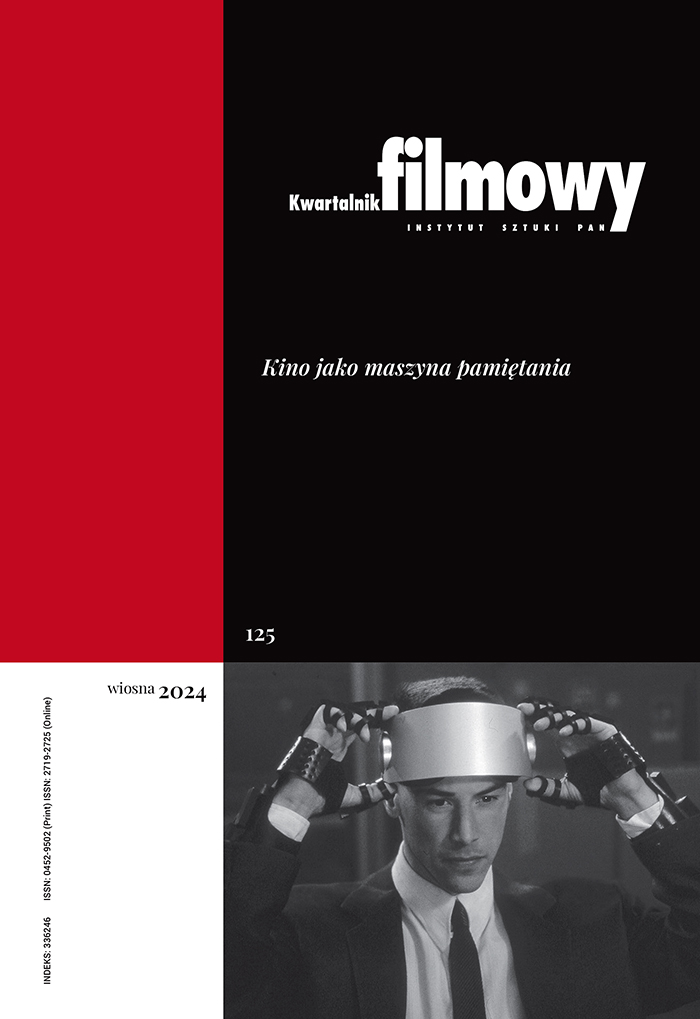Age Rating Categories of Films in Journalism and Letters to the Editor in 1970-1980
Jakub Zajdel
jakub.zajdel@us.edu.plUniversity of Silesia (Poland)
https://orcid.org/0000-0002-8423-2049
Abstract
The author addresses the problem of using age categories in Polish cinemas in 1970-1980. At the outset, he points out that age rating on the one hand restricts access of minors to certain films, and on the other hand regulates the organization of screening for schools. The low age category of the film allows it to be included in the curriculum in the primary classes, and as a result promotes formation through film from an early age. Age categories influenced the viewing of both entertainment and artistic films by minors. Critical views of age categories in force in the period discussed, expressed by viewers and journalists resulted in an attempt to change the system. It turned out that the most contentious issue was the age classification of films showing eroticism and sexuality. An attempt to simplify the age category system was unsuccessful, as evidenced by cinemas’ repertoire.
Keywords:
film culture, Polish People's Republic, cinema audience, Polish cinema, age rating systemReferences
Bajka Z., Czytelnictwo prasy w Polsce Ludowej, Kraków 1976.
Google Scholar
Beam M., Seks na ziemi, terror w powietrzu [nie podano nazwiska tłumacza], „Film” 1970, nr 39 (1138).
Google Scholar
Depta H., Film dozwolony od lat…?, „Film” 1972, nr 40 (1243).
Google Scholar
Depta H., Najważniejsza ze wszystkich sztuk, „Film” 1973, nr 13.
Google Scholar
Depta H., Najprzewrotniejsza ze wszystkich sztuk, „Film” 1973, nr 15.
Google Scholar
„Dobry smak dowodzi bezsiły artysty”, z Andrzejem Żuławskim rozmawiał Mikołaj Wojciechowski. „Ekran” 1972, nr 3 (771).
Google Scholar
Film jako wychowawca, rozmowa z udziałem Janiny Koblewskiej, Anny Tatarkiewicz, Kazimierza Kutza, Andrzeja Wajdy, Krzysztofa Zanussiego i Bolesława Michałka, opracowała Bożena Janicka, „Film” 1972, nr 27 (1230).
Google Scholar
Gazda J., Klęska tradycyjnych kryteriów opisu, „Ekran” 1972, nr 4 (772).
Google Scholar
Gazda J., Nie tylko instytut, „Ekran” 1972, nr 5 (773).
Google Scholar
Helman A., Niebezpieczna gwałtowność czy niebezpieczne kłamstwo?, „Film” 1970, nr 34 (1237).
Google Scholar
Karpiński M., Alarm w sprawie seksu, „Film” 1972, nr 32 (1235).
Google Scholar
Kozakiewicz M., Głosy o złym i dobrym wpływie, „Film” 1972, nr 32 (1235).
Google Scholar
Ledóchowski A., Jak sobie pościelesz, „Film” 1975, nr 16 (116).
Google Scholar
Ledóchowski A., Smuga młodości, „Film” 1976, nr 21 (173).
Google Scholar
Misiak A., Kinematograf kontrolowany. Cenzura filmowa w kraju socjalistycznym i demokratycznym (PRL i USA), Kraków 2006.
Google Scholar
Nadal „W pustyni i w puszczy”, Frekwencja na filmach polskich [niepodpisana notka], „Film” 1974, nr 27 (75).
Google Scholar
Płażewski J., Czerwony filtr młodości, „Ekran” 1972, nr 2 (770).
Google Scholar
Płażewski J., Symbol źle dobrany, „Ekran” 1972, nr 5 (773).
Google Scholar
Redakcja, Zamiast konkluzji, „Film” 1972, nr 37 (1240).
Google Scholar
Rekord „W pustyni i w puszczy”, Frekwencja na filmach polskich [nie podpisana notka], „Film” 1974, nr 11 (59).
Google Scholar
Smoleń-Wasilewska E., Kluby filmowe – dzisiaj, „Film” 1970, nr 15 (1114).
Google Scholar
Sobański O., Do lat szesnastu, „Film” 1973, nr 45.
Google Scholar
Sobański O., Filmy dla dzieci – czy kino rodzinne?, „Film” 1979, nr 13 (1582).
Google Scholar
(Sob.) [Oskar Sobański], Od 1 października trzy kategorie filmów, „Film” 1974, nr 33 (81).
Google Scholar
Starowicz Z. L., Kultura masowa a seks, „Tygodnik Powszechny” 1972, nr 9 (1205).
Google Scholar
Szymański Ł., Dlaczego film polski wspina się na palce?, „Film” 1973, nr 23.
Google Scholar
Wierzewski W. [bez tytułu], „Film” 1970, nr 19 (1118).
Google Scholar
Żygulski K., Widownia lat siedemdziesiątych, „Film” 1970, nr 44 (1143).
Google Scholar
Żygulski K., Uwagi socjologa, „Film” 1972, nr 31 (1234).
Google Scholar
Authors
Jakub Zajdeljakub.zajdel@us.edu.pl
University of Silesia Poland
https://orcid.org/0000-0002-8423-2049
Adiunkt w zakładzie Filmoznawstwa i Wiedzy o Mediach Uniwersytetu Śląskiego. Prowadzi badania w zakresie powojennej historii kina polskiego. W swoich publikacjach opisywał filmowe przedstawienia życia na tzw. Ziemiach Odzyskanych zaraz po wojnie, działalność krytyczno-filmową Jana Józefa Szczepańskiego, twórczość filmową Filipa Bajona, Sylwestra Chęcińskiego, Jana Jakuba Kolskiego i Lecha Majewskiego. Prześledził szkolne lata Kazimierza Kutza. Jest współautorem (z A. Madej) książki Śmierć jak kromka chleba. Historia jednego filmu (1994) oraz autorem publikacji Pokolenia PRL na ekranie w kontekście dokumentów prasowych z epoki (2018). Jest członkiem Polskiego Towarzystwa Badań nad Filmem i Mediami, Polskiego Towarzystwa Kulturoznawczego i Śląskiego Towarzystwa Filmowego.
Statistics
Abstract views: 284PDF downloads: 396
License
Copyright (c) 2019 Kwartalnik Filmowy

This work is licensed under a Creative Commons Attribution-NonCommercial-NoDerivatives 4.0 International License.
The author grants the publisher a royalty-free non-exclusive licence (CC BY 4.0) to use the article in Kwartalnik Filmowy, retains full copyright, and agrees to identify the work as first having been published in Kwartalnik Filmowy should it be published or used again (download licence agreement). The journal is published under the CC BY 4.0 licence. By submitting an article, the author agrees to make it available under this licence.
In issues from 105-106 (2019) to 119 (2022) all articles were published under the CC BY-NC-ND 4.0 licence. During this period the authors granted a royalty-free non-exclusive licence (CC BY-ND 4.0) to use their article in „Kwartalnik Filmowy”, retained full copyright, and agreed to identify the work as first having been published in our journal should it be published or used again.
Most read articles by the same author(s)
- Jakub Zajdel, Media Hybrid as a Set , Kwartalnik Filmowy: No. 85 (2014): Film and Media – the Past and the Future












